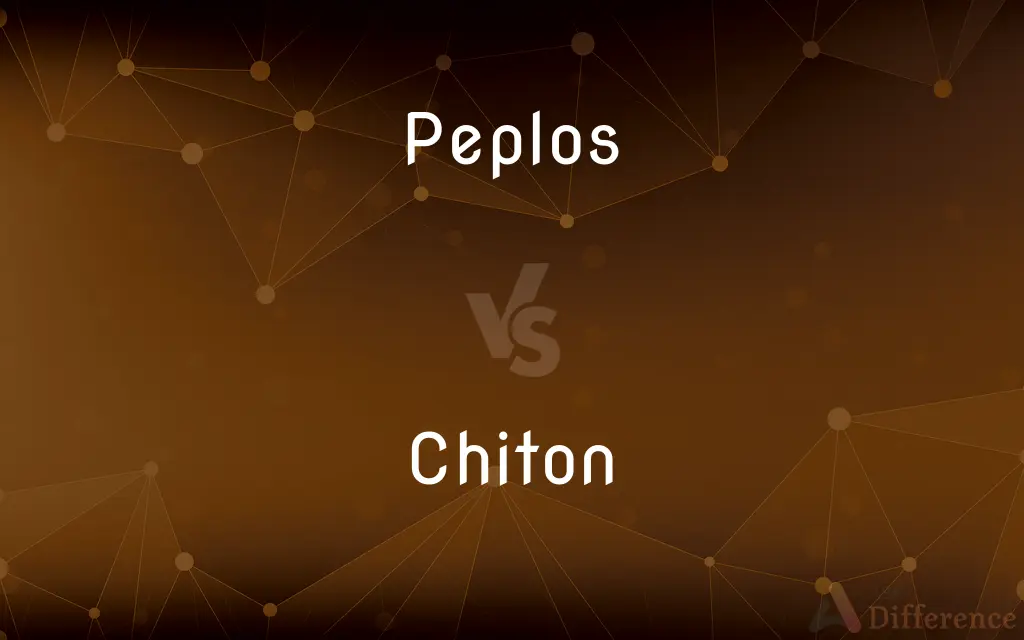Peplos vs. Chiton — What's the Difference?
Edited by Tayyaba Rehman — By Fiza Rafique — Updated on March 28, 2024
Peplos, an ancient Greek garment, was a simple, tubular cloth folded over and pinned at the shoulders, while Chiton was a lighter, often pleated dress secured with pins or buttons, showing more variation in style.

Difference Between Peplos and Chiton
Table of Contents
ADVERTISEMENT
Key Differences
The peplos was a staple of ancient Greek clothing, characterized by its heavy woolen fabric that was draped and folded over the upper body, then pinned at the shoulders, leaving a flap, or apoptygma, over the top. This created a double-layered effect across the chest. In contrast, the chiton, another prevalent ancient Greek garment, was typically made from lighter materials like linen and later silk, and could be either a long or short tunic. It was fastened with pins or buttons at the shoulders and often belted at the waist, allowing for more fluidity and movement than the peplos.
The construction of the peplos involved minimal cutting and sewing, relying on the body and belts to shape the garment, embodying simplicity and functionality. The chiton, however, often required more intricate assembly, including pleating and securing with ornamental pins, reflecting a higher degree of customization and style variability.
In terms of decoration and symbolism, the peplos could be quite plain or decorated, depending on the occasion and status of the wearer, with colors and patterns adding meaning. The chiton, with its broader canvas due to pleating and lighter fabric, offered more opportunities for embellishment and was thus a prime vehicle for expressing wealth, status, or regional identity.
The evolution of Greek clothing saw the chiton becoming increasingly popular due to its versatility and comfort in the Greek climate, gradually overshadowing the more traditional peplos. This shift reflects broader changes in Greek society, including shifts in social norms, aesthetic preferences, and the influence of other cultures, especially through trade and conquest.
Comparison Chart
Material
Heavy wool
Lighter fabrics (linen, silk)
ADVERTISEMENT
Design
Tubular cloth, folded, pinned
Pleated dress, secured with pins/buttons
Gender
Primarily worn by women
Worn by both men and women
Style Variation
Less variation, more structured
More variation, including length
Construction
Minimal cutting and sewing
Often pleated, requiring more assembly
Symbolism/Decoration
Could be plain or decorated
Offered more opportunities for embellishment
Evolution in Greek Society
Became less common over time
Grew in popularity due to versatility
Compare with Definitions
Peplos
An ancient Greek garment for women, made from a heavy woolen fabric.
The statue of Athena was draped in a majestic peplos.
Chiton
A lighter, often pleated garment worn in ancient Greece.
He adjusted his chiton, fastening it with a golden pin.
Peplos
Required minimal tailoring.
The peplos design showcased the ancient Greeks' ingenuity in clothing.
Chiton
Suitable for both men and women.
Their chitons fluttered in the breeze, a testament to the day's celebrations.
Peplos
Often decorated depending on the wearer's status.
Her peplos was adorned with intricate patterns signifying her wealth.
Chiton
Required more intricate construction than the peplos.
The pleats of his chiton were a marvel of craftsmanship.
Peplos
Pinned at the shoulders, creating a double-layered effect.
The apoptygma of her peplos added depth to her attire.
Chiton
Varied in length according to gender and occasion.
Her long chiton grazed the ground, denoting her status.
Peplos
Characterized by its simple, tubular shape.
The peplos she wore was elegantly pinned at the shoulders.
Chiton
Provided a canvas for embellishment and expression.
The silk chiton was embroidered with scenes from mythology.
Peplos
A peplos (Greek: ὁ πέπλος) is a body-length garment established as typical attire for women in ancient Greece by 500 BC (the Classical period). It was a long, rectangular cloth with the top edge folded down about halfway, so that what was the top of the rectangle was now draped below the waist, and the bottom of the rectangle was at the ankle.
Chiton
Chitons are marine molluscs of varying size in the class Polyplacophora , formerly known as Amphineura. About 940 extant and 430 fossil species are recognized.
Peplos
A loose outer robe worn by women in ancient Greece. Also called peplum.
Chiton
A long woollen tunic worn in ancient Greece.
Peplos
(historical) An Ancient Greek garment, worn by women, formed of a tubular piece of cloth, which is folded back upon itself halfway down, until the top of the tube is worn around the waist, and the bottom covers the legs down to the ankles; the open top is then worn over the shoulders, and draped, in folds, down to the waist.
Chiton
A marine mollusc that has an oval flattened body with a shell of overlapping plates.
Peplos
A garment worn by women in ancient Greece; cloth caught at the shoulders and draped in folds to the waist
Chiton
Any of various marine mollusks of the class Polyplacophora that live on rocks and have shells consisting of eight overlapping calcareous plates. Also called sea cradle.
Chiton
A tunic worn by men and women in ancient Greece.
Chiton
(historical) A loose woolen tunic worn by men and women in Ancient Greece.
Chiton
Any of various rock-clinging marine molluscs of the class Polyplacophora, including the genus Chiton.
Chiton
An under garment among the ancient Greeks, nearly representing the modern shirt.
Chiton
One of a group of gastropod mollusks, with a shell composed of eight movable dorsal plates. See Polyplacophora.
Chiton
A woolen tunic worn by men and women in ancient Greece
Chiton
Primitive elongated bilaterally symmetrical marine mollusk having a mantle covered with eight calcareous plates
Common Curiosities
What is a chiton?
A lighter, often pleated ancient Greek garment made from linen or silk, worn by both men and women.
How did peplos and chiton differ in construction?
The peplos was simpler, requiring minimal sewing and was pinned at the shoulders, whereas the chiton could be pleated and secured with pins or buttons, allowing for greater variation.
What materials were used for peplos and chiton?
Peplos were made of heavy wool, while chitons were crafted from lighter fabrics like linen and silk.
Did peplos have any decorations?
Yes, peploses could be plain or decorated, often indicating the wearer's social status.
What made the chiton popular in ancient Greek society?
Its versatility, comfort, and the variety of styles made the chiton popular among both genders.
What is a peplos?
An ancient Greek women's garment, characterized by its heavy wool fabric and simple, tubular design.
Who wore the peplos?
Primarily women in ancient Greece.
How were peplos and chiton similar?
Both were essential elements of ancient Greek attire, reflecting societal norms and aesthetic values.
What role did the apoptygma play in the design of a peplos?
The apoptygma was the fold-over flap at the top of the peplos, created by pinning the fabric at the shoulders, adding depth and structure.
What was the significance of garment decoration in ancient Greece?
Decorations on garments like the peplos and chiton could signify wealth, status, or regional identity, playing an important role in social and cultural expression.
What factors influenced the evolution of Greek clothing from peplos to chiton?
Changes in social norms, aesthetic preferences, climate considerations, and cultural exchanges influenced the shift towards the more versatile chiton.
How do peplos and chiton reflect ancient Greek society and culture?
Through materials, construction, and decoration, these garments embody ancient Greek values of beauty, functionality, and social hierarchy.
How did the design of the chiton allow for more movement?
The lighter fabric and pleated design of the chiton provided more fluidity and ease of movement than the structured peplos.
How did ancient Greeks secure their chitons?
Chitons were fastened with pins or buttons at the shoulders and could be belted at the waist for shape and fit.
Share Your Discovery

Previous Comparison
Methanal vs. Methanol
Next Comparison
Unlaminated vs. LaminatedAuthor Spotlight
Written by
Fiza RafiqueFiza Rafique is a skilled content writer at AskDifference.com, where she meticulously refines and enhances written pieces. Drawing from her vast editorial expertise, Fiza ensures clarity, accuracy, and precision in every article. Passionate about language, she continually seeks to elevate the quality of content for readers worldwide.
Edited by
Tayyaba RehmanTayyaba Rehman is a distinguished writer, currently serving as a primary contributor to askdifference.com. As a researcher in semantics and etymology, Tayyaba's passion for the complexity of languages and their distinctions has found a perfect home on the platform. Tayyaba delves into the intricacies of language, distinguishing between commonly confused words and phrases, thereby providing clarity for readers worldwide.














































